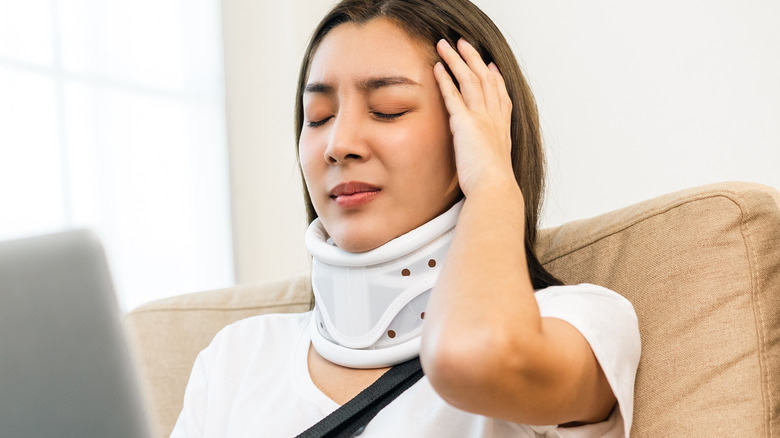Why Is My Left Arm Tingling?
You're lying in bed and looking at your phone, engrossed in a video you can't look away from. You move your arm, and it tingles and starts to hurt. The compression of your body weight on the nerve caused a temporary pinch, and when you moved it, the feeling returned, bringing with it a stabbing, tingling pain that lasts a few minutes.
Temporary nerve compression is annoying, but doesn't necessarily cause serious issues. However, trauma, repetitive movements, or arthritis can lead to bone or muscle inflammation, causing compression on the median, ulnar, or radial nerves within your arm (per Mayo Clinic). No amount of movement will stop the numbness, burning, and tingling sensations that leave your left arm with a constant feeling of falling asleep. In fact, rest, medication, and immobilization are needed to treat the inflammation, states Medical News Today.
Beyond compression, an allergic reaction, bone wear or trauma, carpal tunnel syndrome, neuropathy, anxiety, and poor circulation could be the cause of your left arm tingling. It also might be something more sinister, like a stroke or heart attack. Knowing the symptoms of each can make sure you get the help you need.
Check your arm for an allergic reaction
You've probably been bitten by a mosquito and felt the accompanying itch and irritation. You likely wanted to scratch like your life depended on it, because of your body's reaction to the foreign invader's saliva. An itchy arm is highly annoying, but it's actually one of the more tame allergic reactions from a bite or sting.
When your body overreacts to a bite with histamine, many things can happen, like pain, redness, and numbness near or around the bite site, per the American College of Allergy, Asthma, & Immunology (ACAAI). For example, a wasp or fire ant bites your arm, and the instant swelling and redness cause your left arm to tingle. Better Health Channel notes that the severity of your reaction can vary based on the person. Some people have an intense reaction to bites and stings from bees, wasps, and ants that can cause hives, extreme nausea, swelling of the face, and even difficulty breathing, known as anaphylaxis. This type of severe allergic reaction is a life-threatening emergency that requires immediate treatment, since it can cause death in about 1% of those that suffer symptoms, per 2017 research in The Journal of Allergy and Clinical Immunology in Practice.
Treating your symptoms is vital to ensuring you don't have a severe allergic reaction, like removing the stinger, taking antihistamines, or using an epinephrine pen. Some people with allergies also take preventative action by taking allergy shots (via WebMD).
Trauma to the bone or muscles can cause tingling and numbness
Walking down the hallway, you accidentally bump your left arm or elbow against the door. When the initial hit happens, tingling radiates down the arm for a few minutes while you try to rub out the feeling. Then, after a few days, you're sporting a nice bruise in the area. Tingling can also result from pulling an arm muscle at the gym. Sure, acute injuries leave you with trauma for a minute, but a fracture or a sprain in your left arm might leave you with numbness that lasts a whole lot longer.
Fractures happen when the bone breaks, shatters, or cracks, causing swelling and tenderness, bruising, deformity, and tingling or numbness, states the American Association of Orthopaedic Surgeons (AAOS). Broken bones require immediate treatment to ensure that the bone is properly set and immobilized to heal. Recovery can take several months and involve therapy.
Sometimes, it's not the bones that experience the injury, but the tendons or ligaments; this is known as a sprain. For example, you decide to hit the roller rink after 10 years and fall, twisting your wrist or elbow. The instant swelling from the twisting motion causes pain, trouble moving, bruising, tingling, and stiffness (per Penn Medicine). Wearing a brace to restrict the movement and avoiding movement in the affected body part are both critical to repairing the tendons, but surgery may also be necessary in some cases.
Carpal tunnel syndrome causes tingling
The nerve running through your forearm and hand used for motor functions, temperature, and pain is the median nerve, according to the Cleveland Clinic. Compression of this nerve due to narrowing of the carpal tunnel (a nerve passageway from the forearm to the wrist) causes the numbness and tingling common to carpal tunnel syndrome (per AAOS).
Carpal tunnel syndrome can happen to anyone. However, the National Institute of Neurological Disorders and Stroke (NINDS) notes that those who experience trauma to the wrist, have rheumatoid arthritis, or complete repeat motions with the wrist are more likely to experience symptoms. It can also develop in women (more than men) or people with ailments like diabetes.
Since the inflammation and compression of the nerve can lead to permanent damage, it's important to address your symptoms promptly through medical intervention like splinting, anti-inflammatory drugs like ibuprofen, exercise, therapy, and, in severe cases, surgery. Carpal tunnel release surgery is the most common surgical intervention and relieves the pressure on the nerve by cutting the transverse carpal ligament (per Baylor Medicine).
Peripheral neuropathy can affect the left arm
Your body is full of different neural networks, which help you accomplish everything from reading your mail to riding a wave at Daytona. One example is the peripheral nervous system, which sends sensory information, muscle contraction signals, and digestion signals (per NINDS). Damage to this neural network can drastically impact your life and leave your left arm a little tingly, to say the least.
According to NINDS, signal disruption and symptoms of peripheral neuropathy are estimated in about 20 million people with damage in one or multiple nerve pathways. Additionally, about 60% to 70% of people with diabetes live with peripheral neuropathy in numerous nerve pathways, making it one of the leading causes of this condition. You're also more likely to get this condition with vascular problems, autoimmune diseases, hormonal imbalances, and infections, per NHS Inform.
Living with this disease requires medication and surgery to limit the pain it causes since it has no cure, according to Johns Hopkins Medicine. For instance, your healthcare provider might prescribe braces and aids to help limit your movement or suggest trying physical therapy.
Left arm tingling could be from poor circulation
Your body needs blood to flow to all your vital areas to keep everything oxygenated and happy. A malfunction within the circulatory system makes it harder than average for blood to flow as it should and maintain its homeostasis. This is known as poor circulation. According to LAM Vascular Associates, you aren't going to be diagnosed with poor circulation; rather, conditions like diabetes, artery issues, and heart conditions create tingling and numbness in your arm and a lack of blood flow.
Tingling in your left arm can be caused by poor circulation, but you might also feel tingling in your right thigh or right arm since it can affect any area, per Healthline. Other common symptoms include pain, muscle cramps, ongoing hand numbness, cold skin, and throbbing that makes your fingers ache. Common culprits for those with arm pain might be Raynaud's disease, diabetes, obesity, B-12 deficiency, and a blood clot.
Treating your symptoms will depend on the cause, so you might maintain normal blood glucose levels or see a doctor for a blood clot. It's helpful to eat a well-balanced diet rich in vitamins and minerals and get the recommended amount of exercise to avoid heart and vein issues from obesity. Compression sleeves and blood thinners can also reduce swelling and give your blood a clearer path.
Watch for thoracic outlet syndrome
Compression is the enemy when it comes to the left arm tingling, and it shows no mercy. The fact that your body has lots of cavities and tunnels with limited space means arteries can easily get compressed. One tunnel notorious for compression is the thoracic outlet, running from the collarbone to the rib (via Medical News Today).
Like carpal tunnel syndrome, thoracic outlet syndrome creates compression in the tunnel, making the nerves malfunction and reducing blood flow. The condition comes in three types (arterial, venous, and neurogenic) and includes symptoms like numbness and tingling in the arm and fingers, swelling of the arm and shoulder, and pain, states UC Davis Health. Improper posture is a common culprit, so people who sit at desks, lift weights, and play musical instruments can be more at risk due to repetitive slouching. Anatomical defects, tumors, pregnancy, and trauma could also be to blame for this annoying and painful condition (via NINDS).
Getting a diagnosis is the first step on the road to recovery, but it's by far an easy one. Strengthening the muscles by using proper posture to open up the thoracic outlet requires working with a physical therapist. Your provider might also see fit to prescribe medication to reduce inflammation or perform thoracic outlet decompression surgery.
Cervical spondylosis might cause left arm numbness
Bones are the structure of our body, quite literally. While muscles might make your legs move or your shoulders lift, your bones are the underlying support system. When something goes wrong in the support system due to normal wear and tear from age, your arm pays the price, like with cervical spondylosis. "Cervical" refers to the seven vertebrae found in the neck, while spondylosis is compression from abnormal wear on the bones and soft structures, according to the Hospital for Special Surgery (HSS).
Compression on the nerve roots in your neck leads to pain that spreads down one or both arms, neck stiffness, numbness and tingling, and headaches (via Penn Medicine). While the risk factors aren't concrete for developing this disease, age and previous trauma play a role, and some people might be genetically predisposed due to heredity, states the NHS.
Dealing with the pain isn't an option, so your provider typically orders an x-ray to look for abnormalities in the bones before creating a treatment plan, which may include rest, medication, physical therapy, or surgery. Since degradation of the bones can't be cured just yet, treatment options are only to minimize the pain and symptoms.
A herniated disk correlates with left arm tingles
The spine discs are nearly as important as the bones, since they provide a plush cushion. However, those discs are also prone to herniation when they experience trauma, wear and tear with age, or congenital defects, states the American Association of Neurological Surgeons. The spinal disc is like a pillow between your legs for sleeping, offering a buffer between the leg bones. Since it's compressed between your bones, a small tear causes the stuffing to blow out the side. This means your pillow is relatively flat, and the bones can squeeze down one another, allowing your nerves to get pinched in the mix.
Depending on the nerves or structures the herniation might be compressing, you may feel it in one or both arms, across your shoulders, or with neck movement. Many people might also feel numbness that runs down to their fingers and painful spasms in their arms, making movement and certain positions nearly impossible, according to Mayfield Clinic.
Since an X-ray doesn't show the world what your discs look like, imaging from an MRI or CT scan is necessary to see the rupture of the disk. With a confirmed diagnosis, your provider may start with a conservative treatment like rest, anti-inflammatory meds, muscle relaxers, and steroids to keep you comfortable and allow the disc to heal before prescribing physical therapy. Surgery might be necessary in severe cases to reinflate the disc and relieve those arm tingles for good.
Left arm tingles could be related to hemiplegic migraine
It might seem impossible, but sometimes, your migraine is to blame for the tingles and prickles on your left side. In addition to vision changes, trouble speaking, and a headache, a hemiplegic migraine gives you weakness on one side of your body, causing the tingling and numbness you're feeling on the left side, per the American Migraine Foundation.
This type of migraine can be terrifying since it mimics the symptoms of a stroke, but it's not going to leave you with the devastating effects a stroke can have. WebMD notes that it's typically due to defects or mutations found in four specific genes, which means you have a 50% chance of getting one if your parent has ever had one. However, not everyone has a gene mutation; those without a family history can have a sporadic hemiplegic migraine, according to StatPearls. Moreover, this migraine happens in about 0.01% of the population and is more common in younger individuals.
Given the rarity of the diagnosis, treatment options vary based on your provider, but include medications to help with symptoms like pain, nausea, and auras.
Anxiety might be the cause of the tingling
Say you're in a car accident. The moment the car comes at you, you feel a rush of adrenaline, heightening your senses. Because of that surge of energy, you can swerve to avoid the worst of the accident and save your car. This is called your fight-or-flight response. During an emergency, this reaction can save your life; however, when your body floods you with anxiety on the regular, it creates sensations like numbness and tingling, tunnel vision, and hyperventilation when there isn't an emergency.
The numbness, prickling sensation, and tingles are because your body closes down your blood vessels, states Medical News Today. These can also lead to tense muscles, shaking of your limbs, headaches, and unusual body sensations. Anxiety & Depression Association of America noted that 19.1% of U.S. citizens are suffering from an anxiety disorder, and it strikes all sexes, races, and ages. It can also be nearly impossible to know whether your feelings of dread and numbness are due to anxiety or a more sinister condition, meaning a trip to the doctor's office for treatment options is your best bet.
If you or someone you know needs help with mental health, please contact the Crisis Text Line by texting HOME to 741741, call the National Alliance on Mental Illness helpline at 1-800-950-NAMI (6264), or visit the National Institute of Mental Health website.
Tingling in arms could be a symptom of a stroke
A stroke can strike at any time and at any age, which is what makes it so scary. According to the Centers for Disease Control and Prevention (CDC), a ruptured or blocked artery causes this brain attack by disrupting the sensitive network, causing parts of the brain to become damaged. Your brain is an organ you simply can't live without, so when it sustains such injuries, it's a life-threatening emergency that requires immediate medical attention.
Your brain is the body's motherboard, so a critical error and total system meltdown can happen in minutes. The National Heart, Lung, and Blood Institute states that symptoms of a stroke can take many forms but include confusion and trouble speaking, numbness and tingling on one side of the body, facial drooping, severe headache, difficulty walking, or loss of balance. Without treatment, a stroke can have lasting effects like speech impairment, vision and balance problems, and muscle weakness.
The American Heart Association notes that ischemic stroke, caused by a blood clot blocking the flow, accounts for 87% of all strokes and is treated with medication and surgical intervention. Other types of stroke require different treatment options.
Heart attack can present with tingling in the left arm
There's a reason your healthcare provider tells you to eat well and exercise regularly. Fat can build up in the arteries, cutting off blood flow. Your heart is at the center of your circulatory system, and when the arteries get blocked, oxygen doesn't reach where it should, and parts of the heart begin to become damaged and die (per Heart and Stroke). The cutting off of the blood and dying of the heart muscle is known as a heart attack. Restoring the blood and getting the heart pumping normally again can help save you from lifelong disabilities and even death.
A heart attack comes with a plethora of different symptoms that can vary based on men and women, but chest pain, discomfort in the back and jaw, tightness in the chest, shortness of breath, and uneven heartbeat are common ones, per WebMD. You might also need a surge of anxiety, fatigue, numbness in the left arm, and dizziness. The CDC notes that heart attacks are a common occurrence, with one happening in various parts of the U.S. every 40 seconds.
Treatment is swift when it comes to a heart attack because it's pivotal to get your blood flowing again; therefore, you're given medications like aspirin and nitroglycerin to keep blood flowing. Many times, surgical intervention is needed to remove the clot and add a stent or bypass to prevent the area from getting blocked again, according to Heart and Stroke.













